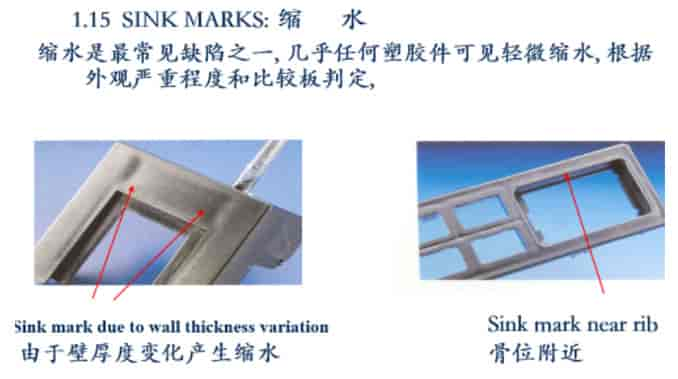
The shrinkage rates of different plastic materials are different. Usually, the raw materials that are prone to sink marks are crystalline, such as nylon. During the injection molding process, the crystalline plastic is heated to a fluid state, with the molecules randomly arranged; when filled into the cold cavity, the plastic molecules are slowly arranged neatly to crystallize. As a result, the volume is shrunk to be smaller than the specified dimensional range, which is referred to as the “sink mark”.
The shrinkage rates of various plastic materials(mold shrinkage rate) are shown below:
Injection processing:
Regarding control of the injection technology, the causes of sink marks include: insufficient pressure, excessively slow injection speed, small gate or long runner. Therefore, when using the injection molding machine, it is necessary to pay attention to the molding conditions and whether the holding pressure is enough to prevent the appearance of sink marks.
The sink marks on a hard-plastic product are usually caused when the molten plastic shrinks due to cooling, but at the same time sufficient melt is not provided through the gate to fill up the space created by concentrated shrinkage. Therefore, factors that are not conducive to shrinkage compensation will affect our solution for the sink mark issue.
Most people know that it is easy to cause sink marks when the mold temperature is too high. Therefore, they usually prefer to solve the problem by lowering the mold temperature. However, sometimes if the mold temperature is too low, it will not be helpful for solving the problem of sink marks.
When the mold temperature is too low, the melt is cooled very fast. For the thick part that is far away from the gate, sufficient shrinkage compensation will not be possible, since the passage in the middle section is blocked due too fast cooling, thus making it harder to solve the sink mark issue. Sink marks on larger and thicker molded products are particularly serious. Therefore, when dealing with tough sink mark issues, it is helpful to check the mold temperature. Each material has its proper mold temperature.
It is not conducive to solving the sink mark issue when the melt temperature is too low
Similarly, most of us know that a plastic injection molded product is prone to the sink mark issue when the melt temperature is too high. If the temperature can be properly lowered by 10 to 20°C, the sink mark issue will be improved.However, when the injection molded part has a sink mark in a relatively thick part, then setting the melt temperature to a too low level, e.g., close to the lower limit of the melt temperature, will not be helpful for solving the sink mark issue, or even make worse. The thicker the injection molded part, the more obvious it is. PC material is a raw material that solidifies quite quickly, so its sink mark issue can be said to be a big problem in plastic injection molding.Also, if the melt temperature is too low, it will not be conducive to increasing the overall shrinkage amount, resulting in an increase in concentrated shrinkage, thereby exacerbating the sink mark issue.
To solve the sink mark issue, the first thing that comes to mind is to raise the injection pressure and extend the injection time. However, if the injection speed is already very fast, it will not be conducive to solving the sink mark issue. Therefore, when it is difficult to eliminate the sink mark, it should be solved by lowering the injection speed. When the injection speed is lowered, a large temperature difference can be created between the melt front and the gate, which is helpful for melt solidification and shrinkage compensation from the far end to the near, while also allowing the sink mark far away from the gate to get a higher pressure for shrinkage compensation, thus helpful for the problem solving. Due to the lowering of the injection speed, the temperature of the melt front is relatively lower, while the speed has been slowed down, so it is not easy for the molded part to flash. The injection pressure and time can be further increased, to better solve the serious sink mark issues.
Mold & Product Design
The mold runner and cooling designs greatly influence the final product. Due to the low heat transfer capacity of the plastic material, it solidifies and cools slowly. There should be enough plastic to fill the cavities, so that the plastic does not flow back to cause pressure drop when the screw of the injection molding machine is performing injection or pressure holding.
On the other hand, the gate cannot solidify too fast, so that the semi-solid plastic will not block the runner and cause pressure drop, and subsequently sink marks on the product. Different mold flow processes lead to different shrinkage rates. The properly controlled barrel temperature is able to prevent the overheating of the plastic part; extending the cycle is able to allow sufficient time for the product to cool down.